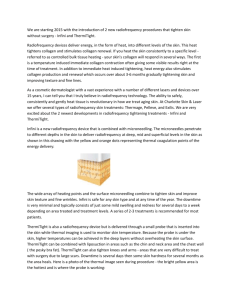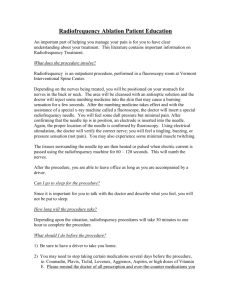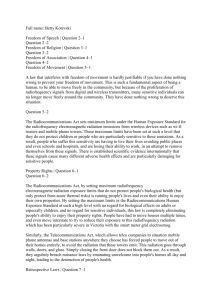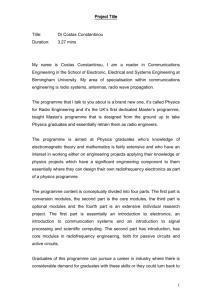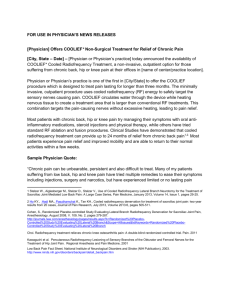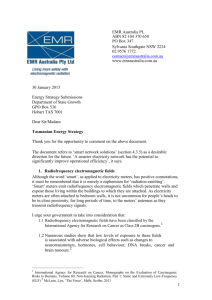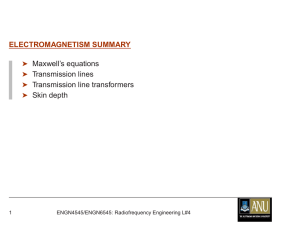Document 14162522
advertisement
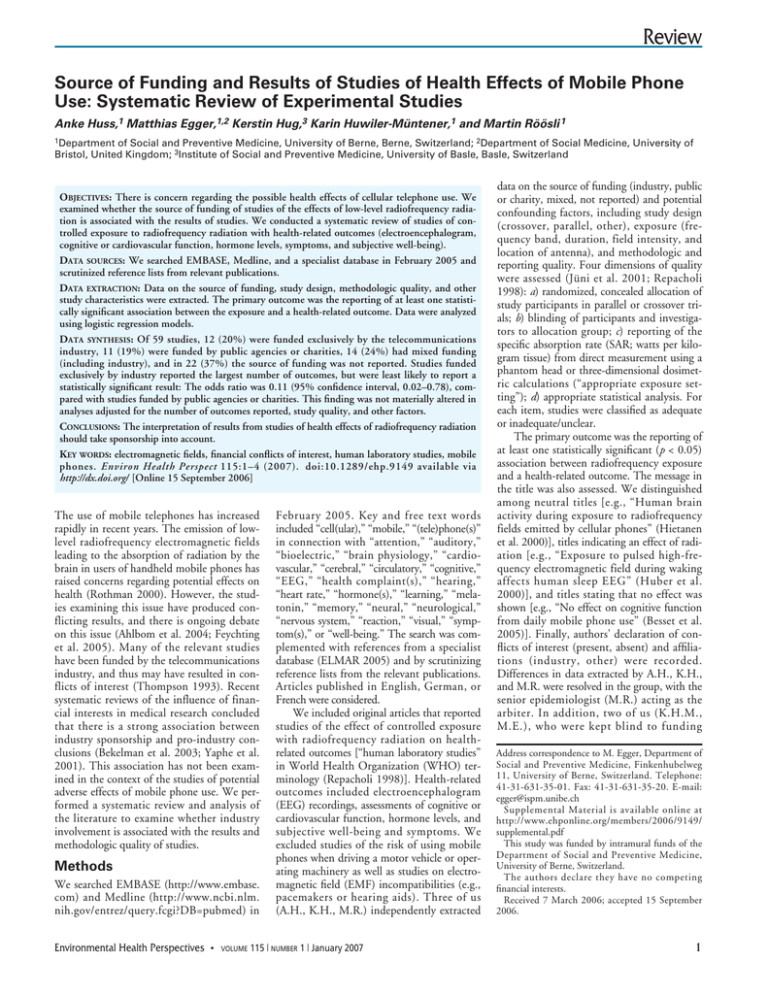
Review Source of Funding and Results of Studies of Health Effects of Mobile Phone Use: Systematic Review of Experimental Studies Anke Huss,1 Matthias Egger,1,2 Kerstin Hug,3 Karin Huwiler-Müntener,1 and Martin Röösli 1 1Department of Social and Preventive Medicine, University of Berne, Berne, Switzerland; 2Department of Social Medicine, University of Bristol, United Kingdom; 3Institute of Social and Preventive Medicine, University of Basle, Basle, Switzerland OBJECTIVES: There is concern regarding the possible health effects of cellular telephone use. We examined whether the source of funding of studies of the effects of low-level radiofrequency radiation is associated with the results of studies. We conducted a systematic review of studies of controlled exposure to radiofrequency radiation with health-related outcomes (electroencephalogram, cognitive or cardiovascular function, hormone levels, symptoms, and subjective well-being). DATA SOURCES: We searched EMBASE, Medline, and a specialist database in February 2005 and scrutinized reference lists from relevant publications. DATA EXTRACTION: Data on the source of funding, study design, methodologic quality, and other study characteristics were extracted. The primary outcome was the reporting of at least one statistically significant association between the exposure and a health-related outcome. Data were analyzed using logistic regression models. DATA SYNTHESIS: Of 59 studies, 12 (20%) were funded exclusively by the telecommunications industry, 11 (19%) were funded by public agencies or charities, 14 (24%) had mixed funding (including industry), and in 22 (37%) the source of funding was not reported. Studies funded exclusively by industry reported the largest number of outcomes, but were least likely to report a statistically significant result: The odds ratio was 0.11 (95% confidence interval, 0.02–0.78), compared with studies funded by public agencies or charities. This finding was not materially altered in analyses adjusted for the number of outcomes reported, study quality, and other factors. CONCLUSIONS: The interpretation of results from studies of health effects of radiofrequency radiation should take sponsorship into account. KEY WORDS: electromagnetic fields, financial conflicts of interest, human laboratory studies, mobile phones. Environ Health Perspect 115:1–4 (2007). doi:10.1289/ehp.9149 available via http://dx.doi.org/ [Online 15 September 2006] The use of mobile telephones has increased rapidly in recent years. The emission of lowlevel radiofrequency electromagnetic fields leading to the absorption of radiation by the brain in users of handheld mobile phones has raised concerns regarding potential effects on health (Rothman 2000). However, the studies examining this issue have produced conflicting results, and there is ongoing debate on this issue (Ahlbom et al. 2004; Feychting et al. 2005). Many of the relevant studies have been funded by the telecommunications industry, and thus may have resulted in conflicts of interest (Thompson 1993). Recent systematic reviews of the influence of financial interests in medical research concluded that there is a strong association between industry sponsorship and pro-industry conclusions (Bekelman et al. 2003; Yaphe et al. 2001). This association has not been examined in the context of the studies of potential adverse effects of mobile phone use. We performed a systematic review and analysis of the literature to examine whether industry involvement is associated with the results and methodologic quality of studies. Methods We searched EMBASE (http://www.embase. com) and Medline (http://www.ncbi.nlm. nih.gov/entrez/query.fcgi?DB=pubmed) in Environmental Health Perspectives February 2005. Key and free text words included “cell(ular),” “mobile,” “(tele)phone(s)” in connection with “attention,” “auditory,” “bioelectric,” “brain physiology,” “cardiovascular,” “cerebral,” “circulatory,” “cognitive,” “EEG,” “health complaint(s),” “hearing,” “heart rate,” “hormone(s),” “learning,” “melatonin,” “memory,” “neural,” “neurological,” “nervous system,” “reaction,” “visual,” “symptom(s),” or “well-being.” The search was complemented with references from a specialist database (ELMAR 2005) and by scrutinizing reference lists from the relevant publications. Articles published in English, German, or French were considered. We included original articles that reported studies of the effect of controlled exposure with radiofrequency radiation on healthrelated outcomes [“human laboratory studies” in World Health Organization (WHO) terminology (Repacholi 1998)]. Health-related outcomes included electroencephalogram (EEG) recordings, assessments of cognitive or cardiovascular function, hormone levels, and subjective well-being and symptoms. We excluded studies of the risk of using mobile phones when driving a motor vehicle or operating machinery as well as studies on electromagnetic field (EMF) incompatibilities (e.g., pacemakers or hearing aids). Three of us (A.H., K.H., M.R.) independently extracted • VOLUME 115 | NUMBER 1 | January 2007 data on the source of funding (industry, public or charity, mixed, not reported) and potential confounding factors, including study design (crossover, parallel, other), exposure (frequency band, duration, field intensity, and location of antenna), and methodologic and reporting quality. Four dimensions of quality were assessed (Jüni et al. 2001; Repacholi 1998): a) randomized, concealed allocation of study participants in parallel or crossover trials; b) blinding of participants and investigators to allocation group; c) reporting of the specific absorption rate (SAR; watts per kilogram tissue) from direct measurement using a phantom head or three-dimensional dosimetric calculations (“appropriate exposure setting”); d) appropriate statistical analysis. For each item, studies were classified as adequate or inadequate/unclear. The primary outcome was the reporting of at least one statistically significant (p < 0.05) association between radiofrequency exposure and a health-related outcome. The message in the title was also assessed. We distinguished among neutral titles [e.g., “Human brain activity during exposure to radiofrequency fields emitted by cellular phones” (Hietanen et al. 2000)], titles indicating an effect of radiation [e.g., “Exposure to pulsed high-frequency electromagnetic field during waking affects human sleep EEG” (Huber et al. 2000)], and titles stating that no effect was shown [e.g., “No effect on cognitive function from daily mobile phone use” (Besset et al. 2005)]. Finally, authors’ declaration of conflicts of interest (present, absent) and affiliations (industry, other) were recorded. Differences in data extracted by A.H., K.H., and M.R. were resolved in the group, with the senior epidemiologist (M.R.) acting as the arbiter. In addition, two of us (K.H.M., M.E.), who were kept blind to funding Address correspondence to M. Egger, Department of Social and Preventive Medicine, Finkenhubelweg 11, University of Berne, Switzerland. Telephone: 41-31-631-35-01. Fax: 41-31-631-35-20. E-mail: egger@ispm.unibe.ch Supplemental Material is available online at http://www.ehponline.org/members/2006/9149/ supplemental.pdf This study was funded by intramural funds of the Department of Social and Preventive Medicine, University of Berne, Switzerland. The authors declare they have no competing financial interests. Received 7 March 2006; accepted 15 September 2006. 1 Huss et al. Potentially eligible articles identified (n = 222) Exclusions based on title or abstract (n = 142) • Studies of the risk of using mobile phones when driving a motor vehicle or operating machinery (n = 29) • Studies of the use of mobile phones in the monitoring of and communication with patients (n = 28) • Other study designs (n = 29) • Studies of interference with hearing aids or pacemakers (n = 28) • Studies of other exposures or methodologic issues (n = 26) • Animal studies (n = 2) 80 full-text articles examined Excluded (n = 21) • Other study design (n = 9) • Published in Chinese or Russian (n = 3) • Publication was withdrawn (n = 1) • Double publications (n = 5) • Studies of reducing exposure (”shielding studies”) (n = 2) • Funded by company producing “shielding devices” (n = 1) 59 studies included in analyses Figure 1. Identification of eligible studies. Results Table 1. Characteristics of 59 experimental studies of the effects of exposure to low-level radiofrequency electromagnetic fields. Study characteristic Study design [no. (%)] Crossover trial Parallel group trial Other, unclear Exposure [no. (%)] Location of antenna Next to ear Other/unclear Frequency banda 900 MHz Other frequencies Unclear Median duration of exposure (range) Outcomes assessed [no. (%)]a Electroencephalogram Cognitive function tests Hormone levels Cardiovascular function Well-being or symptoms Other Study quality [no. (%)]a Randomization adequate Participants and assessors blinded SAR determined Statistical analysis adequate Median study size (range) Industry (n = 12) Source of funding Public or charity Mixed (n = 11) (n = 14) Not reported (n = 22) 10 (83.3) 0 (0) 2 (16.7) 7 (63.6) 2 (18.2) 2 (18.2) 12 (85.7) 1 (7.1) 1 (7.1) 11 (50) 2 (9.1) 9 (40.9) 4 (33.3) 8 (66.7) 8 (72.7) 3 (27.3) 11 (78.6) 3 (21.4) 14 (63.6) 8 (36.4) 11 (91.7) 2 (16.7) 0 (0) 180 (3–480) 8 (72.7) 7 (63.6) 0 (0) 20 (5–35) 13 (92.9) 0 (0) 1 (7.1) 45 (30–240) 14 (63.6) 5 (22.7) 5 (22.7) 30 (4–480) 7 (58.3) 0 (0) 5 (41.7) 2 (16.7) 1 (8.3) 4 (33.3) 5 (45.5) 3 (27.3) 0 (0) 1 (9.1) 1 (9.1) 3 (27.3) 10 (83.3) 1 (8.3) 4 (33.3) 3 (25) 21 (8–38) 7 (63.6) 3 (27.3) 4 (36.4) 3 (27.3) 24 (13–100) 8 (57.1) 8 (57.1) 0 (0) 0 (0) 1 (7.1) 1 (7.1) 12 (54.5) 8 (36.4) 2 (9.1) 2 (9.1) 0 (0) 3 (13.6) 13 (92.9) 8 (57.1) 8 (57.1) 7 (50) 20 (13–96) 9 (40.9) 3 (13.6) 2 (9.1) 1 (4.5) 20 (8–78) Percentages are column percentages. aThe same study could be listed in more than one category. 2 source, authors, and institutions, repeated extraction of data from abstracts and assessments of titles. Differences in data extracted by K.H.M. and M.E. were resolved with the senior epidemiologist (M.E.) acting as the arbiter. Based on the abstracts, we assessed whether authors interpreted their study results as showing an effect of low-level radiofrequency radiation, as showing no effect, or as indicating an unclear finding. We used logistic regression models to assess whether the source of funding was associated with the reporting of at least one significant effect in the article (including the abstract). We examined the influence of potential confounders, such as the total number of outcomes that were reported in the article, the type of study (crossover, parallel, other), the four dimensions of study quality (adequate or not adequate/unclear), exposure conditions (position of the antenna next to the ear compared with other locations; use of the 900MHz band compared with other bands; duration of exposure in minutes), as well as the type of outcome (e.g., cognitive function tests: yes vs. no). Variables were entered one at a time and, given the limited number of studies, models were adjusted for one variable only. Results are reported as odds ratios (ORs) with 95% confidence intervals (CIs). All analyses were carried out in Stata (version 8.2; StataCorp., College Station, TX, USA). VOLUME We identified 222 potentially relevant publications and excluded 163 studies that did not meet inclusion criteria (Figure 1). We excluded one study that had been funded by a company producing “shielding” devices that reduce EMF exposure (Croft et al. 2002). A total of 59 studies were included: 12 (20%) were exclusively funded by the telecommunications industry, 11 (19%) were funded by public agencies or charities, 14 (24%) had mixed funding (including industry and industry-independent sources), and in 22 (37%) studies the source of funding was not reported. None of 31 journals published a statement on possible conflicts of interest of the 287 authors listed in the bylines. Five (8%) studies had authors with industry affiliation. All studies except two (3%) were published in journals that use peer review, and one was published in a journal supplement. The bibliographic references are given in the Supplemental Material (http://www.ehponline.org/members/2006/ 9149/supplemental.pdf). Blinded and open extraction of data yielded identical results with respect to the reporting of statistically significant effects in the abstract and the message of the title. Study characteristics are shown in Table 1. All studies were published during 1995–2005, with the number of publications increasing from one to 115 | NUMBER 1 | January 2007 • Environmental Health Perspectives Source of funding and studies of mobile phone use two publications per year to 11 publications in 2004. Median year of publication was 1998 for industry-funded studies, 2002 for public or charity funding and studies with mixed funding sources, and 2003 for studies that did not report their funding source. The median size of all the studies was small (20 study participants); most studies (n = 32, 54%) were of a crossover design and mimicked the exposure situation during a phone call, using the 900MHz band with the antenna located close to the ear. Exposure duration ranged from 3 to 480 min, with a median of 33 minutes. Thirty-three (59%) studies measured outcomes during exposure, 14 (24%) postexposure, and 12 (20%) at both times. Thirty-nine (66%) studies prevented selection bias with adequate randomization; 15 (25%) blinded both participants and assessors; in 18 (31%) the field intensity had been assessed appropriately, with SAR values ranging from 0.03 to 2 W/kg tissue. Finally, in 14 (24%) studies we considered the statistical analysis to be adequate. Study quality varied by source of funding: Studies with mixed funding (including public agencies or charities and industry) had the highest quality, whereas studies with no reported source of funding did worst (Table 1). Forty (68%) studies reported one or more statistically significant results (p < 0.05) indicating an effect of the exposure (Table 2). Studies funded exclusively by industry reported on the largest number of outcomes but were less likely to report statistically significant results: The OR for reporting at least one such result was 0.11 (95% CI, 0.02–0.78), compared with studies funded by public agencies or charities (Table 3). This finding was not materially altered in analyses adjusted for the number of outcomes reported, study design and quality, exposure characteristics, or outcomes [Table 3; see Supplemental Material, Table 1 (http://www.ehponline.org/members/ 2006/9149/supplemental.pdf)]. Similar results were obtained when restricting analyses to results reported in abstracts (OR = 0.29; 95% CI, 0.05–1.59) or on the conclusions in the abstract (OR = 0.10, 95% CI, 0.009–1.10). Thirty-seven (63%) studies had a neutral title, 11 (19%) a title reporting an effect, and 11 (19%) a title reporting no effect (Table 2). were indeed substantially less likely to report statistically significant effects on a range of end points that may be relevant to health. Our findings add to the existing evidence that single-source sponsorship is associated with outcomes that favor the sponsors’ products (Bekelman et al. 2003; Davidson 1986; Lexchin et al. 2003; Stelfox et al. 1998). Most previous studies of this issue were based on studies of the efficacy and cost-effectiveness of drug treatments. A recent systematic review and meta-analysis showed that studies sponsored by the pharmaceutical industry were approximately four times more likely to have outcomes favoring the sponsor’s drug than studies with other sources of funding (Lexchin et al. 2003). The influence of the tobacco industry on the research it funded has also been investigated (Barnes and Bero 1996, 1998; Bero 2005). To our knowledge, this is the first study to examine this issue in the context of exposure to radiofrequency electromagnetic fields. Discussion Crude Adjusted for No. of reported outcomes Median study size Study design (crossover, parallel, or other) Study quality Randomization adequate Participants and assessors blinded Statistical analysis adequate Exposure setting appropriate We examined the methodologic quality and results of experimental studies investigating the effects of the type of radiofrequency radiation emitted by handheld cellular telephones. We hypothesized that studies would be less likely to show an effect of the exposure if funded by the telecommunications industry, which has a vested interest in portraying the use of mobile phones as safe. We found that the studies funded exclusively by industry Environmental Health Perspectives Our study has several limitations. We restricted our analysis to human laboratory studies. This resulted in a more homogenous set of studies, but may have reduced the statistical power to demonstrate or exclude smaller associations. The WHO has identified the need for further studies of this type to clarify the effects of radiofrequency exposure on neuroendocrine, neurologic, and immune systems (Foster and Repacholi 2004). We considered including epidemiologic studies but found that practically all of them were publicly funded. The study’s primary outcome—the reporting of statistically significant associations—is a crude measure that ignores the size of reported effects. However, we found the same trends when assessing the authors’ conclusions in the abstracts. Although we have shown an association between sponsorship and results, it remains unclear which type of funding leads to the most accurate estimates of the effects of Table 2. Results from assessments of article text, abstract, and title of 59 experimental studies of the effects of exposure to low-level radiofrequency electromagnetic fields. Industry (n = 12) Article text No. (%) of studies with at least one result suggesting an effect at p < 0.05 Median no. (range) of outcomes reported Median no. (range) of outcomes suggesting an effect at p < 0.05 Abstracta No. (%) of studies with at least one result suggesting a significant effect Median no. (range) of outcomes reported Median no. (range) of outcomes suggesting a significant effect Authors’ interpretation of results [no. (%)] No effect of radiofrequency radiation Effect of radiofrequency radiation Unclear finding Title [no. (%)] Neutral Statement of effect Statement of no effect Source of funding Public or charity Mixed (n = 11) (n = 14) 4 (33) 9 (82) 17.5 (4–31) 0 (0–6) Not reported (n = 22) 10 (71) 17 (77) 10 (1–80) 1.5 (0–7) 16 (9–44) 3 (0–15) 7 (1–35) 1.5 (0–12) (n = 12) 4 (33) (n = 11) 7 (64) (n = 14) 10 (71) (n = 20) 15 (75) 3.5 (1–36) 0 (0–6) 3 (1–5) 1 (0–3) 6.5 (3–44) 2 (0–5) 3 (1–64) 1.5 (0–7) 10 (83.3) 1 (8.3) 1 (8.3) 5 (45.5) 5 (45.5) 1 (9) 4 (28.6) 8 (57.1) 2 (14.3) 5 (22.7) 14 (63.6) 3 (13.6) 5 (46) 4 (36) 2 (18) 8 (57) 3 (21) 3 (21) 17 (77) 4 (18) 1 (5) 7 (58) 0 (0) 5 (42) Percentages are column percentages. aTwo publications that did not report their source of funding had no abstracts. Table 3. Probability of reporting at least one statistically significant result (p < 0.05) according to source of funding: crude and adjusted ORs (95% CIs) from logistic regression models. Industry (n = 12) 0.11 (0.02–0.78) Source of funding Public or charity Mixed (n = 11) (n = 14) Not reported (n = 22) p-Valuea 1 (reference) 0.56 (0.08–3.80) 0.76 (0.12–4.70) 0.04 0.12 (0.02–0.89) 1 (reference) 0.60 (0.08–4.28) 0.96 (0.15–6.23) 0.04 0.08 (0.009–0.62) 1 (reference) 0.61 (0.08–4.59) 0.57 (0.08–4.02) 0.02 0.08 (0.01–0.68) 1 (reference) 0.38 (0.05–3.07) 1.16 (0.16–8.61) 0.029 0.04 (0–0.56) 0.14 (0.02–0.96) 0.12 (0.02–0.85) 0.13 (0.02–0.89) 1 (reference) 1 (reference) 1 (reference) 1 (reference) 0.16 (0.01–2.15) 0.54 (0.08–3.91) 0.67 (0.09–4.85) 0.47 (0.07–3.39) 1.27 (0.16–9.89) 0.76 (0.12–4.8) 0.54 (0.08–3.76) 0.86 (0.14–5.5) 0.005 0.09 0.07 0.06 Models adjusted for one variable at a time. aFrom likelihood ratio tests. • VOLUME 115 | NUMBER 1 | January 2007 3 Huss et al. radiofrequency radiation. For example, if researchers with an environmentalist agenda are more likely to be funded by public agencies or charities, then their bias may result in an overestimation of effects. Interestingly, studies with mixed funding were of the highest quality. The National Radiological Protection Board (NRPB 2004) reviewed studies of health effects from radiofrequency (RF) fields and concluded that “scientific evidence regarding effects of RF field exposure from mobile phones on human brain activity and cognitive function … has included results both supporting and against the hypothesis of an effect.” We found that the source of funding explains some of the heterogeneity in the results from different studies. The association was robust and little affected by potential confounding factors such as sample size, study design, or quality. Possible explanations for the association between source of funding and results have been discussed in the context of clinical research sponsored by the pharmaceutical industry (Baker et al. 2003; Bekelman et al. 2003; Lexchin et al. 2003). The association could reflect the selective publication of studies that produced results that fitted the sponsor’s agenda. Sponsors might influence the design of the study, the nature of the exposure, and the type of outcomes assessed. In multivariate logistic regression analysis, the only factor that strongly predicted the reporting of statistically significant effects was whether or not the study was funded exclusively by industry. We stress that our ability to control for potential confounding factors may have been hampered by the incomplete reporting of relevant study characteristics. Medical and science journals are implementing policies that require authors to disclose their financial and other conflicts of interest. None of the articles examined here 4 included such a statement, in line with a survey of science and medical journals that showed that adopting such policies does not generally lead to the publication of disclosure statements (Krimsky and Rothenberg 2001). A review of 2005 instructions to authors showed that 15 (48%) of the 31 journals included in our study had conflict of interest policies. Our results support the notion that disclosure statements should be published, including statements indicating the absence of conflicts of interest. The role of the funding source in the design, conduct, analysis, and reporting of the study should also be addressed. There is widespread concern regarding the possible health effects associated with the use of cellular phones, mobile telephone base stations, or broadcasting transmitters. Most (68%) of the studies assessed here reported biologic effects. At present it is unclear whether these biologic effects translate into relevant health hazards. Reports from national and international bodies have recently concluded that further research efforts are needed, and dedicated research programs have been set up in the United States, Germany, Denmark, Hungary, Switzerland, and Japan. Our study indicates that the interpretation of the results from existing and future studies of the health effects of radiofrequency radiation should take sponsorship into account. REFERENCES Ahlbom A, Green A, Kheifets L, Savitz D, Swerdlow A. 2004. Epidemiology of health effects of radiofrequency exposure. Environ Health Perspect 112:1741–1754. Baker C, Johnsrud M, Crismon M, Rosenheck R, Woods S. 2003. Quantitative analysis of sponsorship bias in economic studies of antidepressants. Br J Psychiatry 183:498–506. Barnes D, Bero L. 1996. Industry-funded research and conflict of interest: an analysis of research sponsored by the tobacco industry through the center for indoor air research. J Health Polit Policy Law 21:515–542. Barnes D, Bero L. 1998. Why review articles on the health effects of passive smoking reach different conclusions. JAMA 279:1566–1570. VOLUME Bekelman JE, Li Y, Gross CP. 2003. Scope and impact of financial conflicts of interest in biomedical research: a systematic review. JAMA 289:454–465. Bero L. 2005. Tobacco industry manipulation of research. Public Health Rep 120:200–208. Besset A, Espa F, Dauvilliers Y, Billiard M, de Seze R. 2005. No effect on cognitive function from daily mobile phone use. Bioelectromagnetics 26:102–108. Croft RJ, Chandler JS, Burgess AP, Barry RJ, Williams JD, Clarke AR. 2002. Acute mobile phone operation affects neural function in humans. Clin Neurophysiol 113:1623–1632. Davidson R. 1986. Source of funding and outcome of clinical trials. J Gen Intern Med 1:155–158. ELMAR. 2005. Dokumentationsstelle ELMAR, Elektromagnetische Strahlung und Gesundheit. Available: www.elmar.unibas.ch [accessed 10 February 2005]. Feychting M, Ahlbom A, Kheifets L. 2005. EMF and health. Annu Rev Public Health 26:165–189. Foster KR, Repacholi MH. 2004. Biological effects of radiofrequency fields: does modulation matter? Radiat Res 162:219–225. Hietanen M, Kovala T, Hamalainen AM. 2000. Human brain activity during exposure to radiofrequency fields emitted by cellular phones. Scand J Work Environ Health 26:87–92. Huber R, Graf T, Cote KA, Wittmann L, Gallmann E, Matter D, et al. 2000. Exposure to pulsed high-frequency electromagnetic field during waking affects human sleep EEG. Neuroreport 11:3321–3325. Jüni P, Altman DG, Egger M. 2001. Systematic reviews in health care: assessing the quality of controlled clinical trials. BMJ 323:42–46. Krimsky S, Rothenberg L. 2001. Conflict of interest policies in science and medical journals: Editorial practices and author disclosures. Sci Eng Ethics 7:205–218. Lexchin J, Bero LA, Djulbegovic B, Clark O. 2003. Pharmaceutical industry sponsorship and research outcome and quality: Systematic review. BMJ 326:1167–1170. NRPB (National Radiological Protection Board). 2004. Health effects from radiofrequency electromagnetic fields. Report of an independent advisory group on non-ionising radiation. Documents of the NRPB 14(2):1–177. Available: http://www.hpa.org.uk/radiation/publications/documents_ of_nrpb/pdfs/doc_14_2.pdf [accessed 3 July 2006]. Repacholi MH. 1998. Low-level exposure to radiofrequency electromagnetic fields: health effects and research needs. Bioelectromagnetics 19:1–19. Rothman KJ. 2000. Epidemiological evidence on health risks of cellular telephones. Lancet 356:1837–1840. Stelfox H, Chua G, O’Rourke K, Detsky A. 1998. Conflict of interest in the debate over calcium-channel antagonists. N Engl J Med 338:101–106. Thompson DF. 1993. Understanding financial conflicts of interest. N Engl J Med 329:573–576. Yaphe J, Edman R, Knishkowy B, Herman J. 2001. The association between funding by commercial interests and study outcome in randomized controlled drug trials. Fam Pract 18:565–568. 115 | NUMBER 1 | January 2007 • Environmental Health Perspectives
